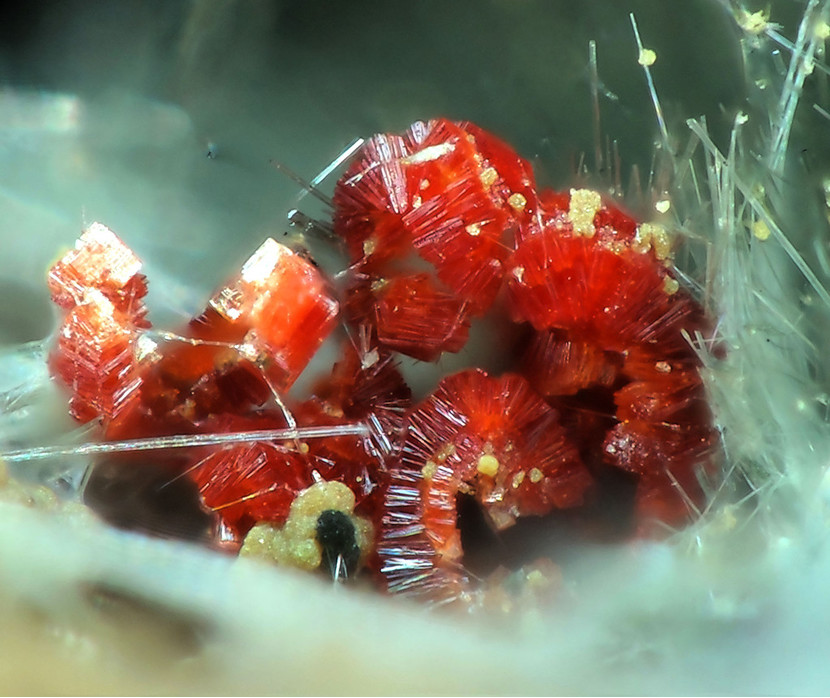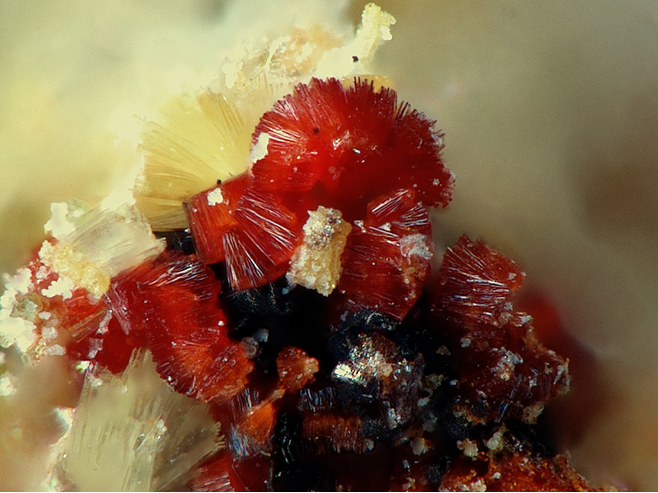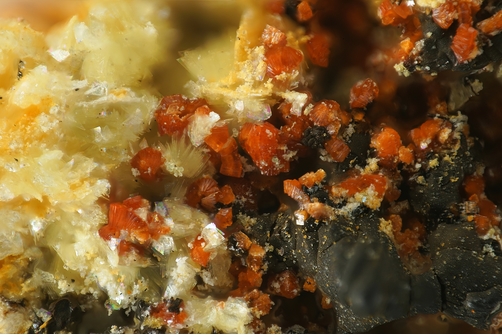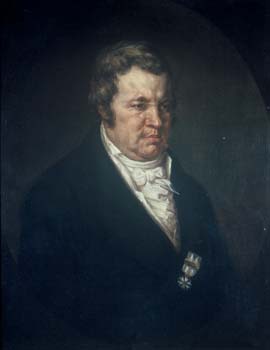Flurlite
A valid IMA mineral species
This page is currently not sponsored. Click here to sponsor this page.
About Flurlite
Formula:
Zn3Mn2+Fe3+(PO4)3(OH)2 · 9H2O
Colour:
Bright orange red to dark maroon red
Specific Gravity:
2.89
Crystal System:
Monoclinic
Name:
Named by I.E. Grey, E. Keck, W.G. Mumme, A. Pring and C.M. MacRae in 2014 in honor of Mathias von Flurl (5 February 1756, Straubing, Bavaria - 27 July 1823, Kissingen, Bavaria), the founder of mineralogical and geological studies in Bavaria. He created the first geological map of Bavaria.
Related to schoonerite.
A re-evaluation of the site occupancies in flurlite, using BVS calculations, resulted in a change in the dominant cation in the M1 site from Mn2+ to Zn. Consequently, the end-member formula for flurlite becomes [5]Zn[6]Zn3[6]Fe3+(PO4)3(OH)2(H2O)7·2H2O (CNMNC Newsletter No. 42).
A re-evaluation of the site occupancies in flurlite, using BVS calculations, resulted in a change in the dominant cation in the M1 site from Mn2+ to Zn. Consequently, the end-member formula for flurlite becomes [5]Zn[6]Zn3[6]Fe3+(PO4)3(OH)2(H2O)7·2H2O (CNMNC Newsletter No. 42).
Unique Identifiers
Mindat ID:
46498
Long-form identifier:
mindat:1:1:46498:5
GUID
(UUID V4):
(UUID V4):
dd655e0e-3cd7-4681-a3d8-2e0cb5613efd
IMA Classification of Flurlite
Approved
IMA status notes:
Redefined by the IMA
IMA Formula:
Zn2+Zn2+3Fe3+(PO4)3(OH)2(H2O)7 · 2H2O
Approval year:
2014
First published:
2015
Approval history:
2014: Approved by IMA as a new species (IMA 2014-064) with the formula Zn3Mn2+Fe3+(PO4)3(OH)2·9H2O.
2017: Revised end-member formula for flurlite (Proposal 17-I),[5]Zn[6]3[6]Fe3+(PO4)3(OH)2(H2O)7·2H2O.
2017: Revised end-member formula for flurlite (Proposal 17-I),[5]Zn[6]3[6]Fe3+(PO4)3(OH)2(H2O)7·2H2O.
Type description reference:
Grey, I. E., Keck, E., Mumme, W. G., Pring, A., Macrae, C. M., Gable, R. W., Price, J. R. (2015) Flurlite, Zn3Mn2+Fe3+(PO4)3(OH)2·9H2O, a new mineral from the Hagendorf Süd pegmatite, Bavaria, with a schoonerite-related structure. Mineralogical Magazine, 79 (5) 1175-1184 doi:10.1180/minmag.2015.079.5.11
Classification of Flurlite
8.DB.40
8 : PHOSPHATES, ARSENATES, VANADATES
D : Phosphates, etc. with additional anions, with H2O
B : With only medium-sized cations, (OH, etc.):RO4< 1:1
8 : PHOSPHATES, ARSENATES, VANADATES
D : Phosphates, etc. with additional anions, with H2O
B : With only medium-sized cations, (OH, etc.):RO4< 1:1
Mineral Symbols
As of 2021 there are now IMA–CNMNC approved mineral symbols (abbreviations) for each mineral species, useful for tables and diagrams.
| Symbol | Source | Reference |
|---|---|---|
| Flu | IMA–CNMNC | Warr, L.N. (2021). IMA–CNMNC approved mineral symbols. Mineralogical Magazine, 85(3), 291-320. doi:10.1180/mgm.2021.43 |
Physical Properties of Flurlite
Transparency:
Translucent
Colour:
Bright orange red to dark maroon red
Streak:
Buff
Comment:
Hardness not described.
Tenacity:
Brittle
Cleavage:
Perfect
Parallel to (001).
Parallel to (001).
Fracture:
Irregular/Uneven
Density:
2.89 g/cm3 (Measured) 2.84 g/cm3 (Calculated)
Optical Data of Flurlite
Type:
Biaxial (-)
RI values:
nα = 1.600(1) nβ = 1.650(1) nγ = 1.680(1)
2V:
Calculated: 74°
Max Birefringence:
δ = 0.080

Image shows birefringence interference colour range (at 30µm thickness)
and does not take into account mineral colouration.
and does not take into account mineral colouration.
Surface Relief:
Moderate
Dispersion:
Weak
Optical Extinction:
Parallel. X ≈ c, Y ≈ a, Z ≈ b.
Pleochroism:
Weak
Comments:
With colours: X = pale yellow, Y = pale orange, Z = orange brown
Chemistry of Flurlite
Mindat Formula:
Zn3Mn2+Fe3+(PO4)3(OH)2 · 9H2O
Crystallography of Flurlite
Crystal System:
Monoclinic
Class (H-M):
2/m - Prismatic
Space Group:
P21/m
Setting:
P21/m
Cell Parameters:
a = 6.3894(8) Å, b = 11.037(1) Å, c = 13.063(2) Å
β = 99.37(2)°
β = 99.37(2)°
Ratio:
a:b:c = 0.579 : 1 : 1.184
Unit Cell V:
908.91 ų (Calculated from Unit Cell)
Z:
2
Morphology:
Platelets forming twisted accordion-like aggregates.
X-Ray Powder Diffraction
Powder Diffraction Data:
| d-spacing | Intensity |
|---|---|
| 12.900 Å | (100) |
| 8.375 Å | (10) |
| 6.072 Å | (14) |
| 5.567 Å | (8) |
| 5.080 Å | (7) |
| 4.297 Å | (21) |
| 3.221 Å | (7) |
| 2.763 Å | (35) |
Comments:
From Type Description.
Geological Environment
Paragenetic Mode(s):
| Paragenetic Mode | Earliest Age (Ga) |
|---|---|
| Near-surface Processes | |
| 23 : Subaerial aqueous alteration by non-redox-sensitive fluids (see also #47) | |
| Stage 4b: Highly evolved igneous rocks | >3.0 |
| 34 : Complex granite pegmatites |
Type Occurrence of Flurlite
General Appearance of Type Material:
As ultrathin (<1 μm) translucent platelets that form characteristic twisted accordion-like aggregates, on mitridatite.
Place of Conservation of Type Material:
Type material is deposited in the mineralogical collections of Museum Victoria, Melbourne, Victoria, Australia, registration number M53238.
Geological Setting of Type Material:
Zoned granitic phosphate pegmatite.
Associated Minerals at Type Locality:
Reference:
Grey, I.E., Keck, E., Mumme, W.G., Pring, A., Macrae, C.M., Gable, R.W., Price, J.R. (2015) Flurlite, Zn3Mn2+Fe3+(PO4)3(OH)2·9H2O, a new mineral from the Hagendorf Süd pegmatite, Bavaria, with a schoonerite-related structure. Mineralogical Magazine: 79: 1175-1184.
Synonyms of Flurlite
Common Associates
Associated Minerals Based on Photo Data:
| 3 photos of Flurlite associated with Jungite | Ca2Zn4Fe3+8(PO4)9(OH)9 · 16H2O |
| 1 photo of Flurlite associated with Stewartite | Mn2+Fe3+2(PO4)2(OH)2 · 8H2O |
Related Minerals - Strunz-mindat Grouping
| 8.DB. | Arangasite | Al2F(PO4)(SO4) · 9H2O |
| 8.DB. | Camaronesite | [Fe3+(H2O)2(PO3OH)]2(SO4) · 1-2H2O |
| 8.DB. | Höslite | Fe3+3(VO4)2(SO4)(OH)(H2O)4 · 3H2O |
| 8.DB.05 | Diadochite | Fe3+2(PO4)(SO4)(OH) · 6H2O |
| 8.DB.05 | Pitticite | (Fe, AsO4, H2O) (?) |
| 8.DB.05 | Destinezite | Fe3+2(PO4)(SO4)(OH) · 6H2O |
| 8.DB.07 | Wilhelmgümbelite | ZnFe2+Fe3+3(PO4)3(OH)4(H2O)5 · 2H2O |
| 8.DB.07 | Schmidite | [Zn2(Fe3+,Mn2+)2Fe3+(PO4)3(OH)3(H2O)6] · 2H2O |
| 8.DB.07 | Wildenauerite | Zn(Fe3+,Mn2+)2MnFe3+(PO4)3(OH)3(H2O)6 · 2H2O |
| 8.DB.10 | Vashegyite | Al11(PO4)9(OH)6 · 38H2O |
| 8.DB.15 | Schoonerite | ZnMn2+Fe2+2Fe3+(PO4)3(OH)2 · 9H2O |
| 8.DB.20 | Sinkankasite | Mn2+Al(PO3OH)2(OH) · 6H2O |
| 8.DB.25 | Mitryaevaite | Al6(PO4)((P,S)O3(OH,O))2F2(OH)2 · 14.5H2O |
| 8.DB.30 | Sanjuanite | Al2(PO4)(SO4)(OH) · 9H2O |
| 8.DB.35 | Sarmientite | Fe3+2(AsO4)(SO4)(OH) · 5H2O |
| 8.DB.40 | Bukovskýite | Fe3+2(AsO4)(SO4)(OH) · 9H2O |
| 8.DB.40 | Manganflurlite | ZnMn2+3Fe3+(PO4)3(OH)2(H2O)7 · 2H2O |
| 8.DB.42 | Bohuslavite | Fe3+4(PO4)3(SO4)(OH) · nH2O |
| 8.DB.45 | Zýkaite | Fe3+4(AsO4)3(SO4)(OH) · 15H2O |
| 8.DB.47 | Lapeyreite | Cu3O[AsO3(OH)]2 · 0.75H2O |
| 8.DB.50 | Giniite | Fe2+Fe3+4(PO4)3(OH)5 · 2H2O |
| 8.DB.50 | Rossiantonite | Al3(PO4)(SO4)2(OH)2(H2O)14 |
| 8.DB.52 | Arctowskite | Al9(PO4)8(OH)3 · 27H2O |
| 8.DB.55 | Sasaite | (Al,Fe3+)14(PO4)11(SO4)(OH)7 · 83H2O |
| 8.DB.60 | Mcauslanite | Fe3Al2(PO4)3(PO3OH)F · 18H2O |
| 8.DB.65 | Goldquarryite | CuCd2Al3(PO4)4F2(H2O,F)2 · 10H2O |
| 8.DB.70 | Birchite | Cd2Cu2(PO4)2(SO4) · 5H2O |
| 8.DB.75 | Braithwaiteite | NaCu5(Ti4+Sb5+)(AsO4)4(HAsO4)2O2 · 8H2O |
Other Information
Health Risks:
No information on health risks for this material has been entered into the database. You should always treat mineral specimens with care.
Internet Links for Flurlite
mindat.org URL:
https://www.mindat.org/min-46498.html
Please feel free to link to this page.
Please feel free to link to this page.
Search Engines:
External Links:
Mineral Dealers:
References for Flurlite
Reference List:
Williams, P. A., Hatert, F., Pasero, M., Mills, S. J. (2015) New minerals and nomenclature modifications approved in 2014 and 2015. Newsletter No 23. Mineralogical Magazine, 79 (1) 51-58 doi:10.1180/minmag.2015.079.1.05
Grey, I. E., Keck, E., Mumme, W. G., Pring, A., Macrae, C. M., Gable, R. W., Price, J. R. (2015) Flurlite, Zn3Mn2+Fe3+(PO4)3(OH)2·9H2O, a new mineral from the Hagendorf Süd pegmatite, Bavaria, with a schoonerite-related structure. Mineralogical Magazine, 79 (5) 1175-1184 doi:10.1180/minmag.2015.079.5.11
Localities for Flurlite
Locality List
 - This locality has map coordinates listed.
- This locality has map coordinates listed.
 - This locality has estimated coordinates.
ⓘ - Click for references and further information on this occurrence.
? - Indicates mineral may be doubtful at this locality.
- This locality has estimated coordinates.
ⓘ - Click for references and further information on this occurrence.
? - Indicates mineral may be doubtful at this locality.
 - Good crystals or important locality for species.
- Good crystals or important locality for species.
 - World class for species or very significant.
(TL) - Type Locality for a valid mineral species.
(FRL) - First Recorded Locality for everything else (eg varieties).
- World class for species or very significant.
(TL) - Type Locality for a valid mineral species.
(FRL) - First Recorded Locality for everything else (eg varieties).
All localities listed without proper references should be considered as questionable.
Germany (TL) | |
| Williams et al. (2015) +1 other reference |
Quick NavTopAbout FlurliteUnique IdentifiersIMA Classification Classification Mineral SymbolsPhysical Properties Optical Data Chemistry Crystallography X-Ray Powder DiffractionGeological EnvironmentType Occurrence SynonymsCommon AssociatesStrunz-MindatOther InformationInternet Links References Localities Locality List







 symbol to view information about a locality.
The
symbol to view information about a locality.
The 



Hagendorf South Pegmatite, Hagendorf, Waidhaus, Neustadt an der Waldnaab District, Upper Palatinate, Bavaria, Germany